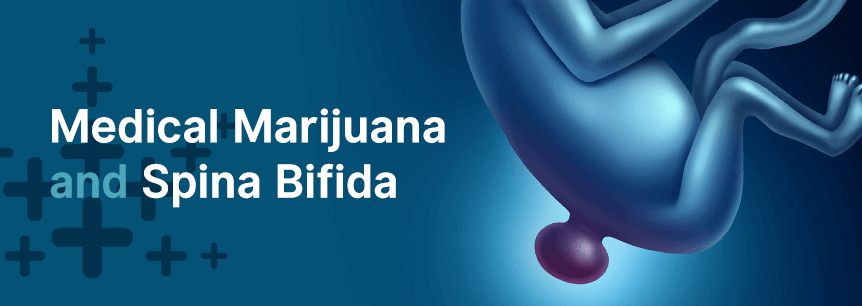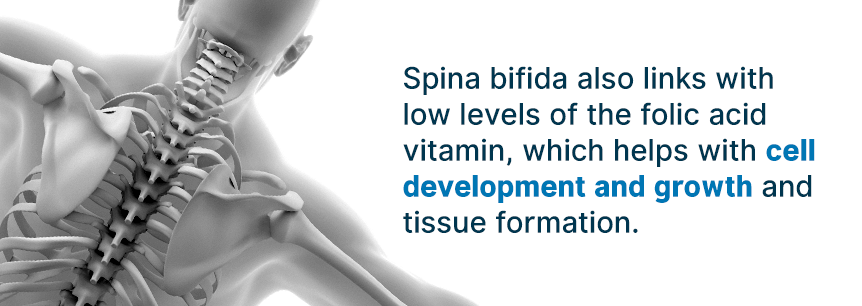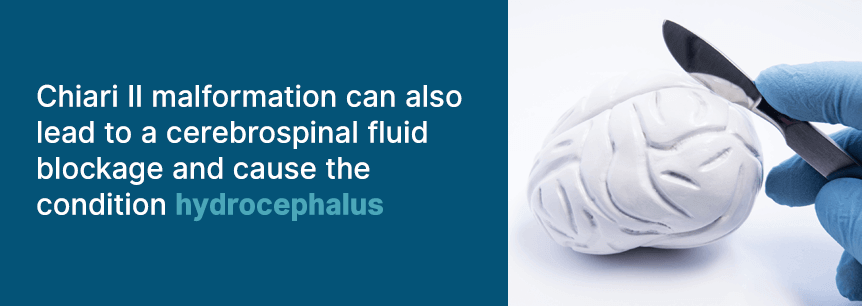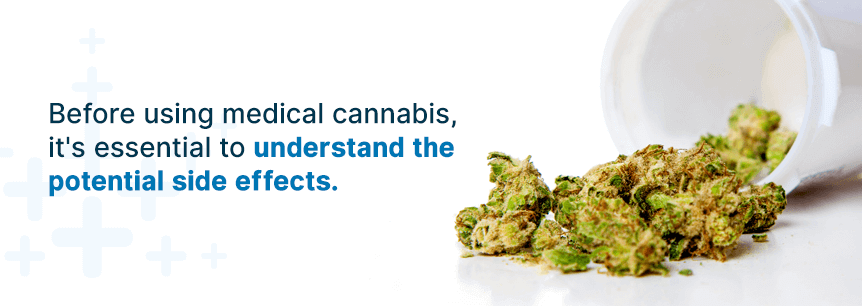
Spina bifida is a common and permanent disabling birth defect. In the U.S., it affects around one out of every 1,500 newborns. Estimates through the Spina Bifida Association show around 70,000 individuals living in the U.S. have spina bifida.
Spina bifida can cause uncomfortable and unpleasant symptoms like pain and muscle spasms. Researchers are studying medical marijuana for spina bifida, and so far there’s been some positive feedback on its results.
Spina bifida is a type of birth defect occurring when the spinal cord and spine don’t correctly form. Medical professionals sometimes place it into the broader neural tube defects category. The neural tube is an embryonic structure developing gradually into a baby’s spinal cord, brain and the tissues enclosing them.
Spina bifida develops in pregnancy during the third and fourth weeks when part of the fetal spinal cord doesn’t close properly, resulting in the baby being born with a portion of their spinal cord exposed. While scientists believe environmental and genetic factors might act together causing spina bifida, around 95 percent of newborns with the condition are born to parents without a family history.
Women with certain chronic medical conditions like seizure disorders and diabetes have a higher risk — around one in 100 — of delivering a baby with spina bifida.
There are four spina bifida types:
Occulta is the most common and mildest form where the person has one or more malformed vertebrae. The term “occulta” means “hidden” and indicates a skin layer covers the opening in the vertebrae or malformation. This type of spina bifida doesn’t usually cause symptoms or disability.
Closed neural tube defects consist of a distinct group of defects, including bone, fat or meninges malformations. In most cases, you experience a few or no symptoms. In some cases, however, the deformity can lead to incomplete paralysis with bowel and urinary dysfunction.
With meningocele, meninges and spinal fluid stick out through an irregular vertebral opening — the malformation doesn’t contain any neural elements and might or might not be covered by a skin layer. Some people with meningocele might experience some or no symptoms, while others could experience issues like complete paralysis with bowel and bladder dysfunction.
Myelomeningocele, another form of spina bifida, is the most severe variety and occurs when your neural or spinal cord elements are exposed through the spinal opening, leading to complete or partial paralysis of the parts of your body below the opening of the spine. The impairment can be so severe the affected person might have bowel and bladder dysfunction and can’t walk.
Spina bifida also links with low levels of the folic acid vitamin, which helps with cell development and growth and tissue formation. When a woman doesn’t have enough of this vitamin in her diet before and during early pregnancy, it can increase her risk of spina bifida as well as other neural tube defects.

The causes of this condition in a pregnancy when the mother did get sufficient folic acid and took her prenatal vitamins remain unknown. Genes could play a role — however, most newborns born with spina bifida don’t have a family history of the condition.
If you have a high fever while pregnant, it could increase your chances of having a newborn with spina bifida. Women suffering from epilepsy who took the medication valproic acid to control their seizures also have a higher risk of having a baby with the condition.
The most obvious sign in spina bifida occulta may be a birthmark or tuft of hair at the defect site. With myelomeningocele and meningocele, you can see the sac sticking out through the newborn’s back. With meningocele, there might also be a thin skin layer over the sac.
There’s typically no skin covering with myelomeningocele, and the spinal cord tissue remains exposed. Other symptoms and signs of myelomeningocele include uneven hips, unusually shaped feet, and a curved spine. Weak leg muscles are another symptom, and sometimes a newborn can’t move their legs at all. Seizures and bladder and bowel problems are other symptoms.
Children also may have difficulty swallowing, breathing or moving their upper arms. They may also be overweight. The symptoms you experience will depend significantly on which spinal nerves are involved and where the issue is in the spine.
Spina bifida complications can extend from mild physical issues with little functional impairment to more severe mental and physical disabilities. Most individuals with this condition are of average intelligence.
The impact of spina bifida can depend on the location and size of the malformation, whether the spine is covered and the involved spinal nerves. It impacts all nerves below the defect to some degree. So, the higher the deformity is on your back, the greater loss of muscle sensation and function and amount of nerve damage you’ll experience.
Along with paralysis and abnormal sensation, another neurological complication linked with spina bifida is Chiari II malformation — common in kids with myelomeningocele where the cerebellum and brainstem protrude downward into the neck area or spinal canal. Myelomeningocele can cause spinal cord compression as well as various other symptoms, including the following.
Chiari II malformation can also lead to a cerebrospinal fluid blockage and cause the condition hydrocephalus — an abnormal cerebrospinal fluid buildup around and in the brain. Cerebrospinal fluid is a clear liquid surrounding the spinal cord and brain. The fluid buildup puts pressure on these structures that can cause damage.

Doctors commonly treat hydrocephalus by surgically implanting a hollow tube or shunt in the brain to drain the buildup of fluid into the abdomen.
Some babies with myelomeningocele might develop meningitis, an infection that can be life-threatening and cause brain injury.
Children with both myelomeningocele and hydrocephalus might have learning disabilities, like trouble with math and reading comprehension. They may also have difficulty paying attention and problems with language.
As children with spina bifida get older, they can suffer from additional problems, as well.
Treatment for spina bifida will depend on the condition’s severity. Often, spina bifida occulta doesn’t require treatment, but other forms do. Some treatments include:
Babies with spina bifida can experience worsened nerve function after birth if they don’t receive treatment. A surgeon can perform fetal surgery before the 26th week of pregnancy. They expose the mother’s uterus surgically to repair the baby’s spinal cord.
Many babies with myelomeningocele are in a feet-first position. Your doctor may recommend a cesarean birth if your baby is in a breech position or if they detect a large sac or cyst.
With meningocele, the surgeon puts the meninges back in place surgically and closes the vertebrae opening. Since meningocele babies’ spinal cord develops normally, the surgeon may often remove these membranes with little to no nerve pathway damage.
Myelomeningocele requires surgery, too. The surgeon will operate early to help reduce the risk of infection linked with the exposed nerves, and it could also protect the spinal cord from additional trauma.
During the surgery, the surgeon will place the exposed tissue and spinal cord inside the baby’s body and cover them with skin and muscle. They may position a shunt during the spinal cord surgery to control hydrocephalus in the baby’s brain.
Babies with myelomeningocele may already have irreparable nerve damage and will require ongoing care from a multispecialty team of doctors, surgeons and therapists. Babies with myelomeningocele might need more surgery for some complications. Doctors start treatment soon after birth for complications such as bowel and bladder issues, weak legs and hydrocephalus, which is fluid buildup in the brain’s cavities.
Depending on how severe the complications and spina bifida are, treatment might include the following.
Most newborns with myelomeningocele will require a ventricular shunt to manage fluid buildup due to hydrocephalus. The surgeon places this tube right after birth, during the procedure for closing the sac on the baby’s lower back or later on when fluid starts to accumulate.
Special equipment like commode chairs, bath chairs, and standing frames might help spina bifida patients function. Whatever the complication — tethered spinal cord, orthopedic problems, skin problems, GI issues or others — doctors can treat most complications in spina bifida or at least manage them to improve quality of life.
There have been suggestions of using cannabis as a treatment for a wide range of medical conditions. Medical marijuana and spina bifida treatment is one of them since the herb has various properties that could help with managing spina bifida.

A study found administering a selective cannabinoid agonist provides effective therapy for the treatment of spinal cord injury after trauma, thereby improving neurological function.
Other studies validate medical marijuana’s ability to treat many of Spina Bifida’s signature symptoms, like:
The herb has also helped users improve bowel and bladder control. And, according to studies, not only has cannabidiol (CBD), one cannabinoid in cannabis, shown remarkable painkilling properties, but it also helps reduce spasticity and improve motor function in spinal cord injury patients.
Marijuana and spina bifida treatment helps patients manage their symptoms. And, as you just read, studies show the herb can improve pain, bladder control, sleeping problems, depression, bowel control, spasticity, and other spina bifida symptoms.
Spinal cord issues can cause pain medical cannabis can help treat. Spina bifida sufferers will typically require long-term medical care. So, people need a safe alternative to traditional pain relievers and sedatives for these conditions. Medical weed shows promise in this area as well. It reduces painful spasms and cramp-like pain.
Strains for pain include:
Medicines to treat sleeping problems like insomnia are often addictive and come with dangerous side effects. Using medical pot to treat insomnia is an effective and safer alternative for many individuals without those harsh side effects. Anecdotal evidence has shown patients are experiencing good results when using the herb to improve their sleep.

Strains for insomnia include:
Your bladder stores urine from your kidneys, but in patients with spinal cord problems, your brain might not be able to control your bladder, increasing your risk of urinary tract infections. You might also be susceptible to bladder or kidney stones or kidney infections. Marijuana for spina bifida helps you gain control over your bladder.
It appears cannabinoids other than tetrahydrocannabinol (THC) in marijuana, like CBD and cannabinol, might reduce some of the unpleasant effects some individuals experience with THC and have a positive contribution to bladder symptoms. Therefore, you may want to try CBD-rich strains like Cannatonic, which is high in CBD content and also helps with muscle spasms, pain, anxiety, insomnia, and depression.
Even though your stomach and intestines continue normal function, people with spina bifida may have difficulty controlling their bowel movements. Medical marijuana has also been shown to help with bowel control.
Some strains for bowel control you may want to try are:
Research on THC shows the cannabinoid can help improve spasticity. The endocannabinoid system takes the THC up, blocking lesion inflammatory action and enhancing communication between nerves and muscles. Also, because it minimizes inflammation, cannabis doesn’t just keep spasticity under control, it also protects against further nerve degeneration.
Strains for spasticity include:
The cannabinoids in medical marijuana for spina bifida react with your endocannabinoid receptors. Some of these receptors impact your mood directly, meaning the herb can alleviate depression.
Strains for depression include:
Medical weed at times can produce some physical and psychological side effects. Not everyone will experience the same side effects, and the impact you get will depend on the type of strain and method of use you use.

Before using medical cannabis, it’s essential to understand the potential side effects.
There are numerous ways to take marijuana for spina bifida.
Taking medical cannabis doesn’t mean you have to smoke a bowl or joint. As you can see, you can benefit from your marijuana treatment in far less obvious ways.
For more information on marijuana and spina bifida treatment and to begin your cannabis therapy, you’ll need a recommendation from a licensed cannabis doctor. You’ll then need to obtain a medical marijuana card to buy your cannabis products. Once you have that, feel free to search our extensive medical weed dispensary list to start shopping for your marijuana products so you can improve your quality of life.
Find A Doctor Find A Dispensary